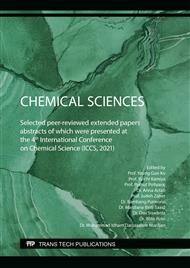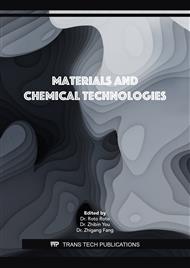[1]
G. Ting, An Overview of Peat Related Chemistry, Undergraduate Thesis, Centria University of Applied Sciences, (2015).
Google Scholar
[2]
I.C. Feustel, H.G. Byers, The physical and chemical characteristics of certain American peat profiles, Technical Bulletin 214, US Department of Agriculture, 1930, p.1–27.
Google Scholar
[3]
D.M.S. Delicato, Physical-Chemical Properties and Sorption Characteristics of Peat, Dissertation, Dublin City University, (1996).
Google Scholar
[4]
J.P. Andriesse, The main characteristics of tropical peats, in: Nature and Management of Tropical Peat Soils, Rome: Food and Agriculture Organization of the United Nations, 1988, p.19–44.
Google Scholar
[5]
D. Charman, Peatlands and Environmental Change, Wiley, Chichester, UK, (2002).
Google Scholar
[6]
L. Bragazza, C. Siffi, P. Iacumin, R. Gerdol, Mass loss and nutrient release during litter decay in peatland: The role of microbial adaptability to litter chemistry, Soil Biol. Biochem. 39 (2007), 257–267.
DOI: 10.1016/j.soilbio.2006.07.014
Google Scholar
[7]
R. Veloo, S. Paramananthan, E. Van Ranst, Classification of tropical lowland peats revisited: The case of Sarawak, Catena 118 (2014) 179–185.
DOI: 10.1016/j.catena.2014.01.004
Google Scholar
[8]
M. Cunico, Pyrolysis of peat: An experimental investigation, Thesis, The University of Padua, (2015).
Google Scholar
[9]
M.S. Boroujeni, Different routes for conversion of coal into liquids comprehensive study, Proceedings of the World Congress on Engineering and Computer Science –WCECS 2008, San Francisco, October 22–24, (2008).
Google Scholar
[10]
Ministry of Housing and Local Government Malaysia, Survey on SW composition, characteristics & existing practice of SW recycling in Malaysia, Final Report, (2013).
Google Scholar
[11]
D.J. Boron, E.W. Evans, J.M. Peterson, An overview of peat research, utilization, and environmental considerations, Int. J. Coal Geol. 8 (1987), 1–31.
Google Scholar
[12]
R.A. Rapaport, S.J. Eisenreich, Historical atmospheric inputs of high-molecular-weight chlorinated hydrocarbons to Eastern North America, Environ Sci Technol. 22 (1988) 931–941.
DOI: 10.1021/es00173a011
Google Scholar
[13]
A.A. Ali, B. Ghaleb, M. Garneau, H. Asnong, J. Loisel, Recent peat accumulation rates in minerotrophic peatlands of the Bay James region, Eastern Canada, inferred by 210Pb and 137Cs radiometric techniques, Appl. Radiat. Isot. 66 (2008), 1350–1358.
DOI: 10.1016/j.apradiso.2008.02.091
Google Scholar
[14]
N. Stivrins, I. Ozola, M. Gałka, E. Kuske, T. Alliksaar, T.J. Andersen, M. Lamentowicz, S. Wulf, T. Reitalu, Drivers of peat accumulation rate in a raised bog: Impact of drainage, climate, and local vegetation composition, Mires Peat 19 (2017), 1–19.
Google Scholar
[15]
A. Javanshah, A. Saidi, Determination of humic acid by spectrophotometric analysis in the soils, Int. J. Adv. Biotechnol. Res. 7 (2016) 19–23.
Google Scholar
[16]
L. Gandois, A.R. Cobb, I.C. Hei, L.B.L. Lim, K.A. Salim, C.F. Harvey, Impact of deforestation on solid and dissolved organic matter characteristics of tropical peat forests: Implications for carbon release, Biogeochemistry, 114 (2013) 183–199.
DOI: 10.1007/s10533-012-9799-8
Google Scholar
[17]
S.J. Chapman, C.D. Campbell, A.R. Fraser, G. Puri, FTIR spectroscopy of peat in and bordering Scots pine woodland: Relationship with chemical and biological properties, Soil Biol. Biochem. 33 (2001) 1193–1200.
DOI: 10.1016/s0038-0717(01)00023-2
Google Scholar
[18]
H. Biester, K.H. Knorr, J. Schellekens, A. Basler, Y.M. Hermanns, Comparison of different methods to determine the degree of peat decomposition in peat bogs, Biogeosciences 11 (2014) 2691–2707.
DOI: 10.5194/bg-11-2691-2014
Google Scholar
[19]
M.M. Tfaily, W.T. Cooper, J.E. Kostka, P.R. Chanton, C.W. Schadt, P.J. Hanson, C.M. Iversen, J.P. Chanton, Organic matter transformation in the peat column at Marcell experimental forest: Humification and vertical stratification, J. Geophys. Res.: Biogeosci. 119 (2014) 661–675.
DOI: 10.1002/2013jg002492
Google Scholar
[20]
Britannica, The Editors of Encyclopaedia. Humic acid,, Encyclopedia Britannica, https://www.britannica.com/science/humic-acid, Accessed on 6 December (2021).
Google Scholar



